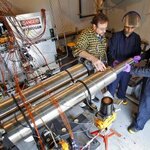Science category landing
Earth Sciences

AUGUSTA, Ga. – Dental amalgam has been proven safe and effective for years, yet unfounded controversy still surrounds it, a Medical College of Georgia researcher says.
Dentists have used amalgam, an alloy of mercury with at least one other metal, in fillings for over 200 years. Amalgam fillings don't contain enough mercury to cause potential health problems associated with larger doses, says Dr. Rod Mackert, professor of dental materials in the MCG School of Dentistry Department of Oral Rehabilitation.
"The dose makes the poison," he says, quoting 16th century Swiss physician Paracelsus. A…

DALLAS – April 2, 2009 – Researchers at UT Southwestern Medical Center have shed light on how the neurotransmitter dopamine helps brain cells process important information.
Researchers found in a study of mouse cells that this neurotransmitter, one of the molecules used by nerve cells to communicate with one another, causes certain brain cells to become more flexible and changes brain-cell circuitry to process important information differently than mundane information.
"This can help one remember a new, important episode as distinct from any other episode, such as remembering where you…

WEST LAFAYETTE, Ind. - Researchers have developed a critical part of a hydrogen storage system for cars that makes it possible to fill up a vehicle's fuel tank within five minutes with enough hydrogen to drive 300 miles.
The system uses a fine powder called metal hydride to absorb hydrogen gas. The researchers have created the system's heat exchanger, which circulates coolant through tubes and uses fins to remove heat generated as the hydrogen is absorbed by the powder.
The heat exchanger is critical because the system stops absorbing hydrogen effectively if it overheats, said Issam Mudawar,…

Van Bael and colleagues used laboratory colonies of one leaf cutter ant species, Atta colombica, to test the ants' response to leaves from a tropical vine, Merremia umbellata, in which they had experimentally manipulated the densities of one fungal endophyte species, Glomerella cingulata, in order to present the ants with leaves containing either high or low levels of fungus. They also pitted 32 additional endophytic fungal strains against cultures of the garden cultivar in Petri plates to find out if they would restrict each others' growth.
Ants cut leaves that contained both high or low…

WASHINGTON, April 2, 2009 — With the Jewish holiday of Passover beginning at sundown next Wednesday, April 8, a staple of the traditional dinner –– chicken soup with matzoh balls –– may take on medicinal importance based on findings published in the American Chemical Society's Journal of Agricultural and Food Chemistry.
The popular home remedy for the common cold sometimes known as "Grandma's Penicillin" may have a new role alongside medication and other medical measures in fighting high blood pressure, scientists in Japan are reporting.
Ai Saiga, Ph.D., and colleagues cite previous studies…

LOS ANGELES (April 2, 2009) – Those suffering from chronic obstructive pulmonary disease (COPD) often complain that exercise is too exhausting and leaves them breathless. An article in the current issue of the New England Journal of Medicine reports that supervised exercise through pulmonary rehabilitation can actually reduce their feelings of breathlessness, increase their tolerance for exercise and improve their quality of life.
The article's lead author is Richard Casaburi, Ph.D., M.D., a senior investigator at the Los Angeles Biomedical Research Institute at Harbor-UCLA Medical Center (LA…

Astronomy & Astrophysics is publishing the first high-resolution image of the young binary system Theta1 Orionis C, located in the Orion Trapezium cluster. This image was obtained by a team of astronomers led by Stefan Kraus and Gerd Weigelt (MPIfR, Bonn, Germany), using the AMBER instrument installed at the ESO/Very Large Telescope Interferometer (VLTI). AMBER is an interferometer beam combiner for the VLT, sensitive in the near-infrared wavelength range (from 1 to 2.5 microns). Details on this instrument and on earlier results are available in previous A&A press releases (Feb. 21,…

Many longtime sailors have been mesmerized by the dazzling displays of green light often seen below the ocean surface in tropical seas. Now researchers at Scripps Institution of Oceanography at UC San Diego have uncovered key clues about the bioluminescent worms that produce the green glow and the biological mechanisms behind their light production.
Marine fireworms use bioluminescence to attract suitors in an undersea mating ritual. Research conducted by Scripps marine biologists Dimitri Deheyn and Michael Latz reveals that the worms also may use the light as a defensive measure. The report…

New Haven, Conn. — Butterflies seem able to both attract mates and ward off predators using different sides of their wings, according to new research by Yale University biologists.
Trying to find the balance between these two crucial behaviors is one of nature's oldest dilemmas, according to Jeffrey Oliver, a postdoctoral associate in Yale's Department of Ecology and Evolutionary Biology and lead author on the study, which appears online today in the journal Proceedings of the Royal Society B: Biological Sciences.
"You want to be noticeable and desirable for mates, but other onlookers,…

INDIANAPOLIS – Compassion fatigue in nurses, doctors and other front line cancer-care providers significantly impacts how they interact with patients, with patient families, with other healthcare workers, and with their own family, according to analysis by Indiana University School of Medicine and Regenstrief Institute researchers published in the March issue of the Journal of Health Psychology.
"The healthcare field is becoming more aware of the profound emotional disturbances that occur in healthcare providers when they witness the suffering and pain of their patients in the face of an…